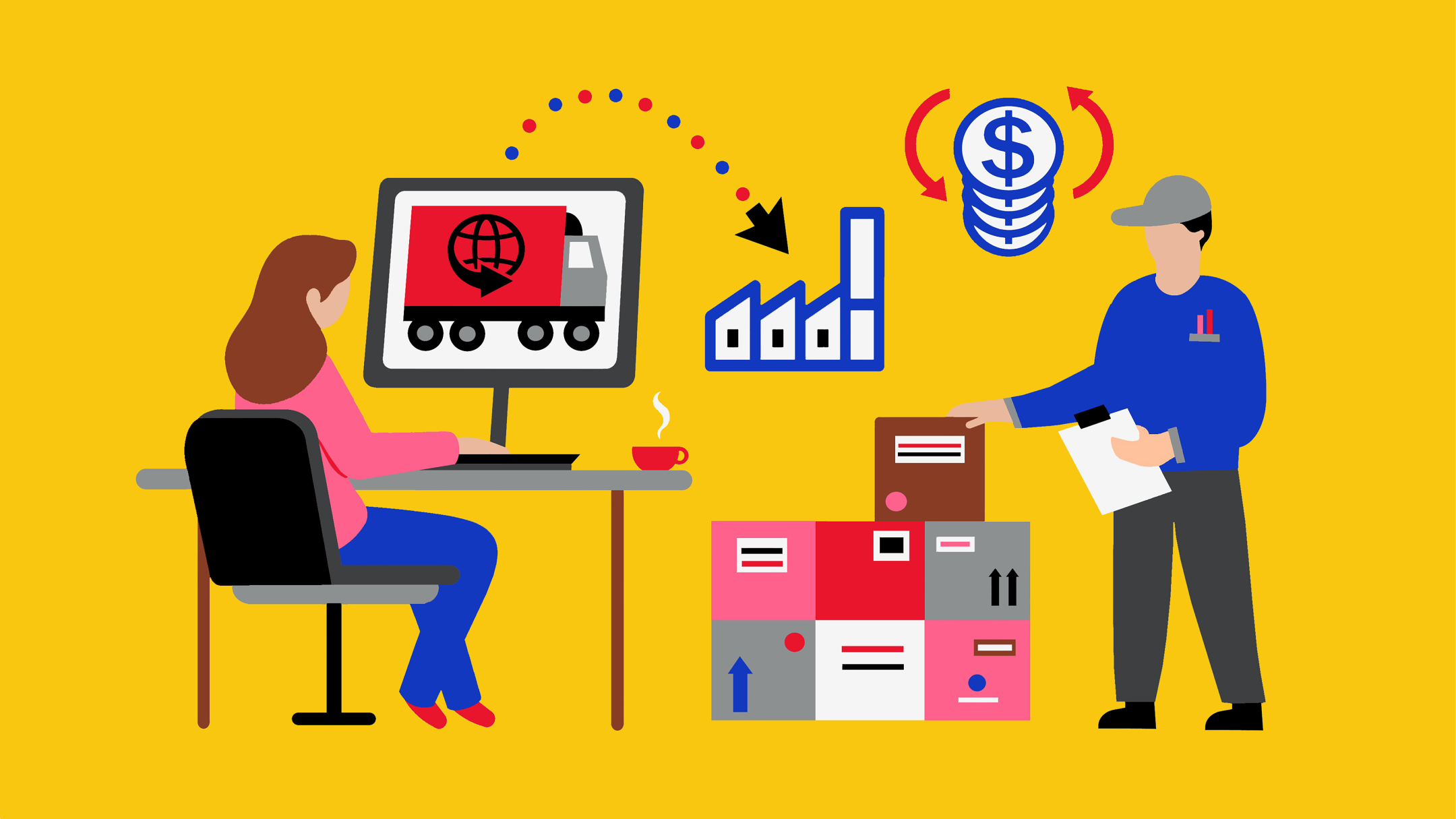Ecommerce has transformed the way businesses sell. But shipping products to global customers comes with its own set of challenges—especially the logistical nightmare of product returns.
Product returnsare something every ecommerce business deals with. The situation can arise for many reasons—the most popular being the item doesn’t fit (70%), they’ve received a damaged or defective product (65%), or the item doesn’t match the product description (49%).
Reverse logistics handles these returns. It encompasses everything from a customer’s decision to return the product to it arriving back at your warehouse and into sellable inventory.
With10.6% of online-bought itemseventually making their way back to the retailer, it’ll come as no surprise to hear that the global reverse logistics market is estimated to be worth$821.55 billionby 2025.
So, how does your brand manage a constant wave of product returns? This guide shares how to make the returns process easier for customersandyour online store with reverse logistics.
Table of Contents
- What is reverse logistics?
- The benefits of a robust reverse logistics process
- 逆向物流的挑战
- How to implement a reverse logistics process
- Should I outsource reverse logistics?
What is reverse logistics?
Reverse logistics is the return process of an order. It is the process of moving the product from the customer to the original point of origin.
If a customer is returning a t-shirt they ordered from your ecommerce store, for example, reverse logistics would bring the unwanted inventory back to your store to be resold, reused, recycled, or refurbished.
It’s not just ecommerce returns that need a robust reverse logistics process, though. Any item making its way back to your warehouse needs to be tracked and handled appropriately, including:
- Rented products
- Items unable to be delivered to a customer
- Unsold inventory from third-party retailers and distributors (including products that have reached the end of their shelf life)
The reverse logistics process
When a product makes its way back to your warehouse, the reverse logistics process looks something like this:
- The customer decides to ship a product back to the retailer.
- The customer drops off the item at a pickup point or at a local store, or uses a returns label to post it back to the retailer’s warehouse.
- Once the item arrives, the retailer decides what to do with the inventory. Incoming returns go through a review process, where any sellable items are placed back on the shelf. Faulty or damaged items are put to one side to be recycled or refurbished.
- The customer is refunded (if their order qualifies).
Reverse logistics vs. traditional logistics
Traditionalecommerce logisticsrefers to the supply chain process that delivers a product to a customer. Once a customer places an order via your online store, the logistics process picks, packs, and ships it to their home. It’s also known as “forward logistics” for this reason.
Reverse logistics handles moving inventory in the opposite direction. It’s a less popular route for inventory to flow (the fewer returned items, the better). But it’s still crucial to have a system in place to handle returns—one that doesn’t dissuade your customers from purchasing again.
The benefits of a robust reverse logistics process
Ecommerce returns deserve the same attention as outgoing shipments. Let’s take a look at why an effective reverse logistics process is critical for ecommerce brands.

Cost savings
Storage space isn’t getting any cheaper. By 2024, retailers will be facing a140-million-square-footstorage shortage, expected to increase the cost of warehousing.
Overcome that (and save your bottom line) with a streamlined reverse logistics process—one that processes returns quickly and efficiently, resulting in faster inventory turnarounds.
Some21% of a company’s logistical costsare spent on inventory carrying. Reverse logistics offers cost savings because it puts sellable items back on the shelf to be sold, while discarding others and freeing up storage space.
Increased customer satisfaction
Regardless of the direction of your inventory, customer loyalty is yours to win. The returns experience is just as important as the experience shoppers have when purchasing products through your online store.
Put yourself in your customer’s shoes. You’re left in the dark when returning an item; you don’t know when you’ll get your money back or if a replacement is on the way. That’s not a good customer experience.
But if you’re provided with updates at each point in the returns process and receive a refund quickly, you’re more likely to try another product from the same retailer. There’s no risk attached. Customers know that even if the second purchase they make eventually needs returning, the process is hassle free.
No wonder76% of first-time buyersthat had an “easy” or “very easy” returns experience said they would shop with that retailer again.
Sustainability
These days, it’s not just price and quality that shoppers care about. Modern consumers want to know the brands they’re shopping with (and returning products to) are sustainable. So much so that34% of consumerschoose brands that haveenvironmentally sustainable practicesor values.
证明你通过你可持续性的承诺ur reverse logistics operations. Jon Carder, co-founder and CEO ofVessel, says, “Customers will participate in a company’s reverse logistics practices when they feel they’re doing something beneficial beyond themselves.
“One example is clothing retailer H&M. The chain collects used clothing in any condition at all their stores, and not just clothing that they’ve sold. The store uses the garments to create a clothing line made exclusively of used clothes. This system empowers people to get involved with a brand that prioritizes an eco-friendly way to sell clothing.”
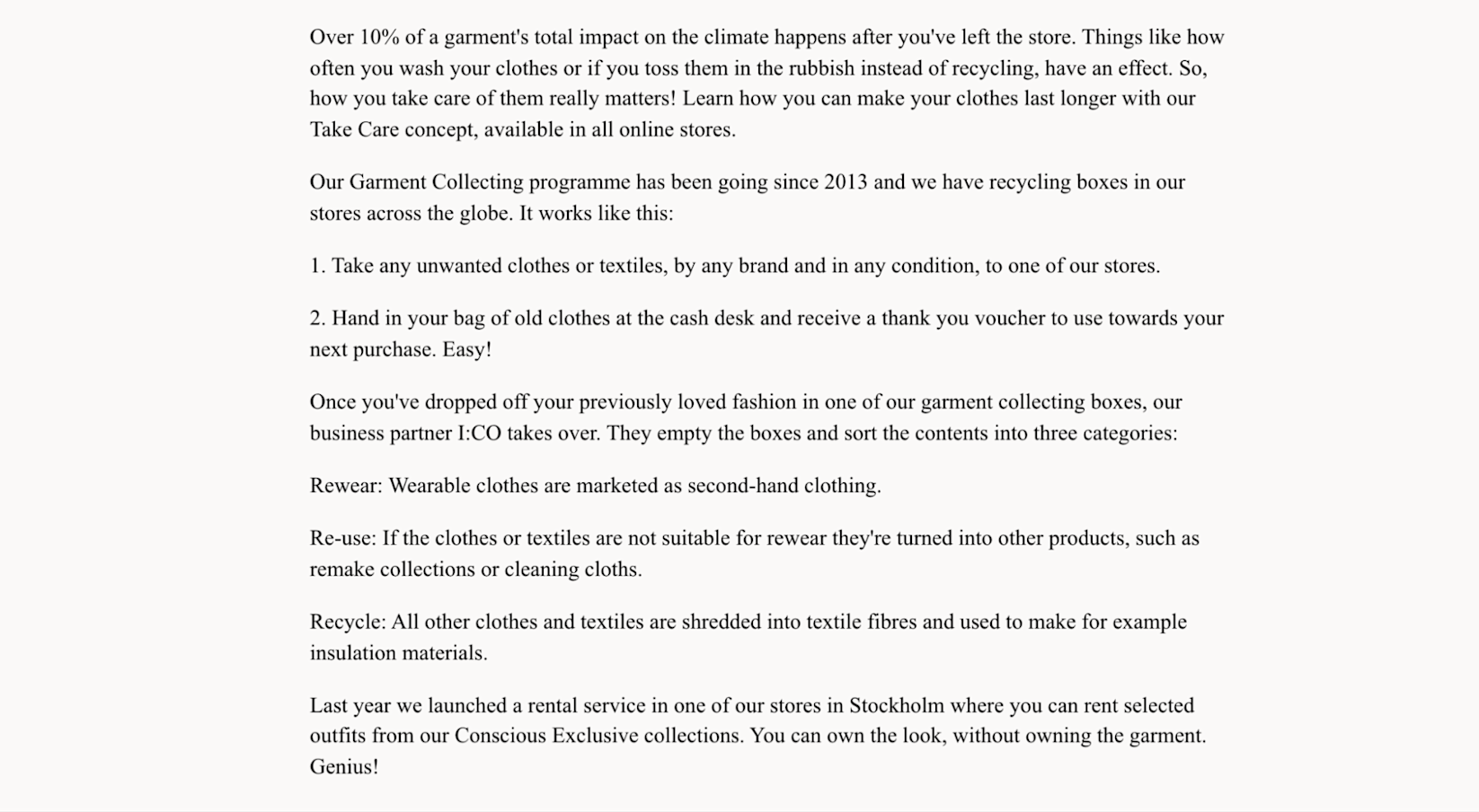
Collect important data
包括返回形式作为反向罗技的一部分stics process for insight into your products. Analyze them to find areas for improvement—tweaks to make to your inventory that could limit the number of products being diverted back to your warehouse.
Pay close attention to:
- Items with the highest return rates
- Most popular reason for returns
- Common faults or damages
Let’s put that into practice and say your hair straighteners are your most returned item. Three-quarters of people who return the item do so because they didn’t realize the product only worked on wavy hair. Prevent this from happening—and your returns warehouse from being overrun with unsold inventory—by updating the product description on your website.
On the flip side, if you’re processing too many returns because the straighteners arrive damaged, quality control your inventory, invest in protective packaging, orchoose a new shipping supplier.
逆向物流的挑战
投资于一个逆向物流程序显然has its benefits, but there are pitfalls to be aware of when planning your new process. Here are some of the biggest challenges when dealing with returns—and how to overcome them.
Customer expectations
There are only a certain number of hours in the day. And even with a large team powering your warehouse, processing returns and dealing with customer service queries is time consuming.
The blunt truth is: customers don’t care. They have strict expectations for the returns experience—and many won’t return to purchase from your store if you don’t hit the mark.
The biggest challenge for reverse logistics is the sheer amount of time it takes to process one return versus shipping out one order. It takes at least two to three times the amount of time. This challenge is exacerbated by labor shortages in our warehouse team.”
—Brian Lim, Founder and CEO ofINTO THE AM
Solve this problem by clearly communicating your returns policy before the point of purchase. Explain when a refund is possible, the window of opportunity to return inventory, and how long customers should expect to wait for the return to be processed.
Quality control
Products involved in your return supply chain have been returned for a reason—be it that the customer ordered the wrong size or the item was faulty. A poor return logistics process leaves room for unsellable inventory to make its way back onto the shelf.
Prevent this from happening by establishing quality standards. Have your team test all returned inventory, not just those labelled as “wrong size” or “incorrect color” on the returns form. Does it still have the tags attached? Does it show obvious signs of use? Any product should be in pristine condition before restocking.
Do the same with anythird-party logistics providersyou’re working with to process returns. Share your quality standards with them and do random spot checks to make sure imperfect inventory is flagged.
It might seem like you’re throwing inventory away if it falls short of your quality standards, but remember the long-term impact. Reselling damaged inventory increases the likelihood of the same product being returned.
Lack of ownership
Who manages your reverse logistics process? Some retailers say their warehouse teams; others leave the responsibility with their operations manager. A handful simply say, “We’re not sure—it’s a mix of different roles.”
McKinsey & Company foundthat for 58% of businesses, a lack of accountability for returns management is a pain point for the company. Nobody to control the process means the responsibility (and therefore, your returns) are passed from pillar to post.
Without an owner, structure, processes, or comprehensive metrics, it is no surprise that companies have struggled to prioritize returns management.”
—McKinsey & Company
Overcome this problem by establishing a team to own your reverse logistics process. Scaling businesses could leave the responsibility to theinventory managementteam, while brands in the $10 million revenue range lend people from the supply chain team to manage reverse logistics.
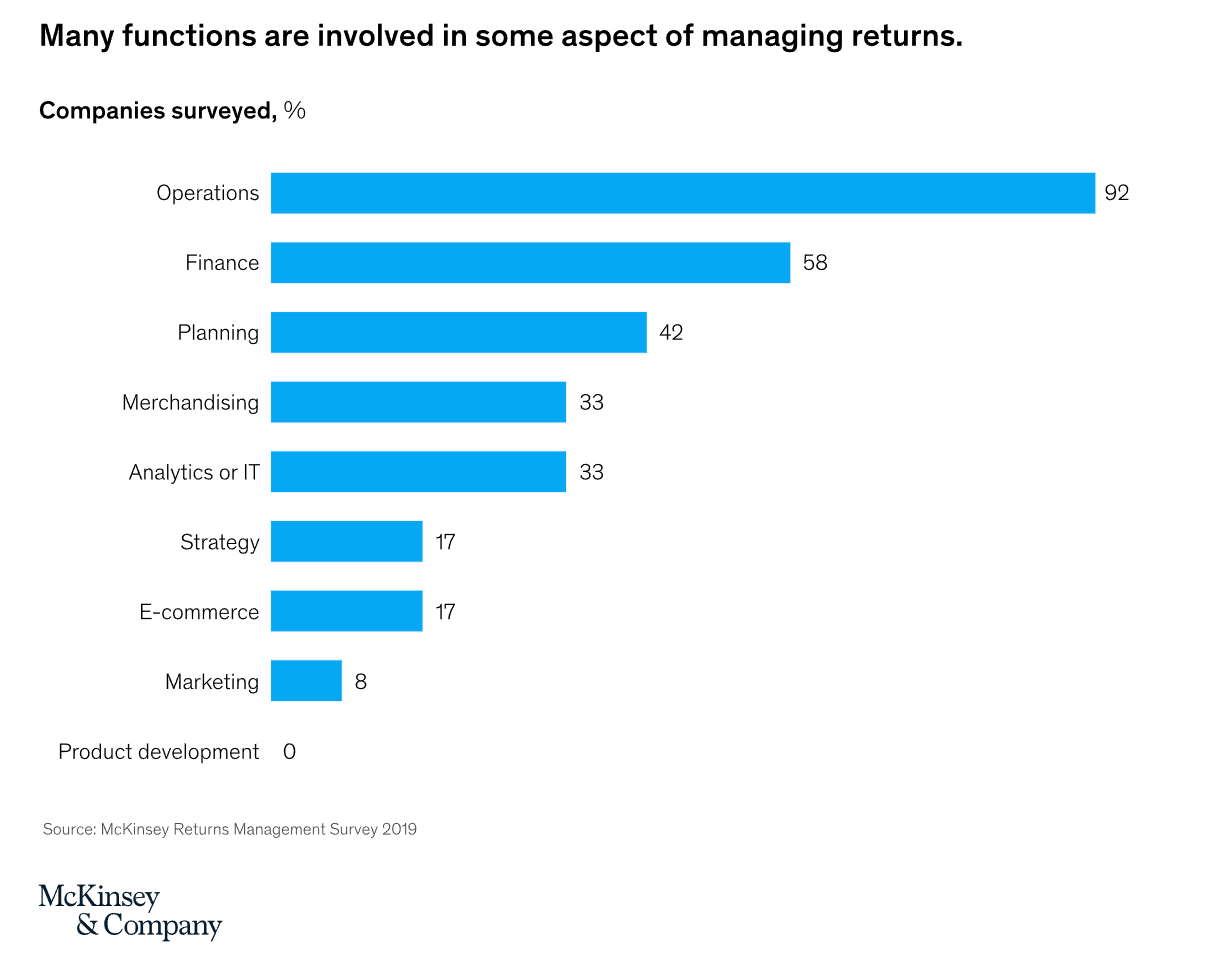
How to implement a reverse logistics process
There’s no way around it: a reverse logistic process needs to be enjoyable for everyone involved, no matter how many customer returns your business handles. There’s a lot at stake—customer satisfaction and loyalty included.
Here’s how to build asupply chainprocess that makes it quick and easy to handle returns, without falling short on customer expectations.
Choose a returns channel
The first step is to determine how a customer ships the product back to your warehouse. Options include:
- Posting by mail.Should a customer want to exchange or refund the product, they can use a return label to post it back to the retailer. This option is preferred by37% of customers.
- Return to the store.If you have brick-and-mortar stores, allow shoppers who’ve bought items online to return it in their closest store.
- Parcel pickup stations.Instead of pushing customers toward the post office, allow them to drop off their returns package at a nearby DHL Service Point or UPS Access Point. Of people who choose this option,41% do sobecause they’re able to consolidate errands in the same trip.
From the retailer’s perspective, one channel reigns supreme: in-store drop off. Not only can processing returns in-store save up to18 daysin the reverse logistics process, but driving customers in-store could reduce returns and increase revenue.
More retailers are putting a heavier emphasis on ‘return to store’ as the more convenient option. That doesn’t prevent returns, but it does make them cost less to the retailer.”
—Nikki Baird, VP of Retail Innovation at Aptos
Customers who return items because they purchased the wrong size can easily get a replacement in-store, eliminating the need for returns altogether.
Plus, driving shoppers into your retail store gives you another opportunity to sell to them. Provide in-store experiences, engage browsers with friendly retail staff, and place low-cost items next to the checkout desk—all of which are techniques shown toimprove retail conversion rates.
It’s why brands like Walgreens are incentivizing shoppers to return FedEx items in-store.
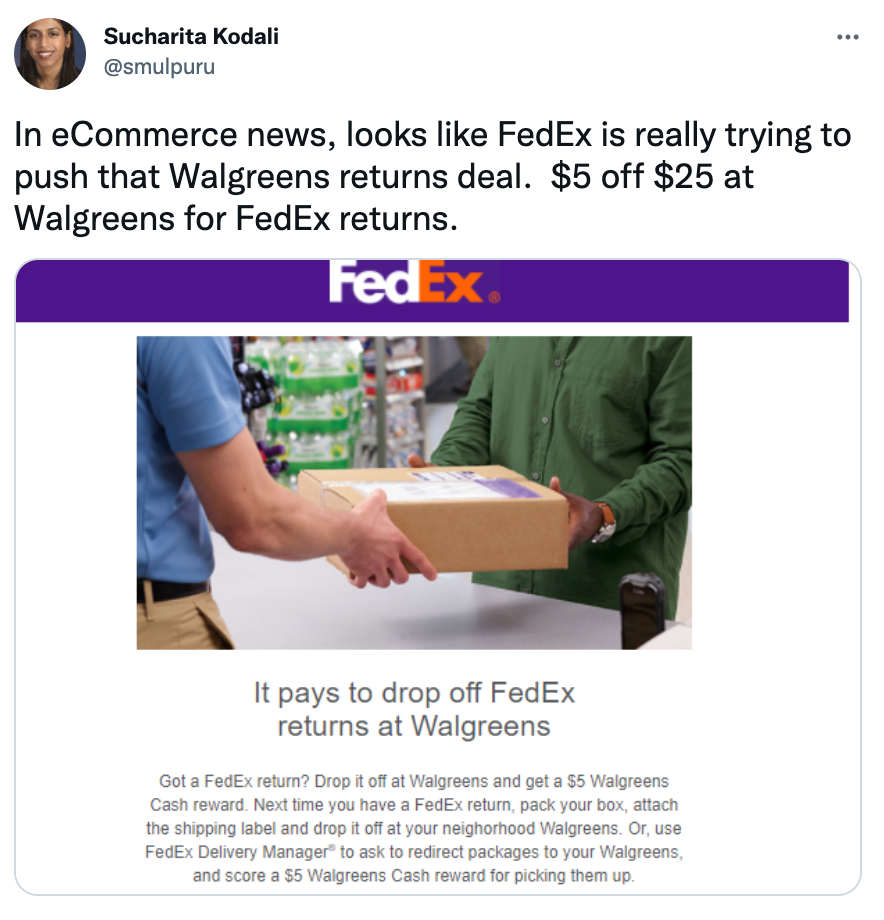
Determine your return policy
A退货政策explains the criteria an order (or product) needs to meet in order to qualify for a refund.
Not only can this minimize products being sent to the warehouse that you’re unable to refund, but you can increase the conversion rate of your online store. Some54% of buyersare put off from purchasing a product they want if the retailer has a poor or unclear return policy.
Your return policy should include:
- Return window.How many days does a customer have to return their item? Areturn window of 30 dayscan increase conversions by 57%.
- What qualifies for a refund.Does the product need to be unused with tags? If the official returns window has passed, does it still need to be under warranty in order to qualify for a refund?
- The type of refund on offer.Do you give store credit, exchange, or money back?
- Who pays for return shipping.Some22% of D2C brandscharge for return shipping, though many bake the cost of returns into their product price.
Need help creating yours? Use Shopify’sfree refund policy template, then upload it to the policies section of your store:
Have a designated space to handle returns
Once items make their way back to your warehouse, build a dedicated workspace for inventory to be processed and inspected.
“Sometimes returns can be messy and that can make you frustrated,” says Erin LaCkore, founder ofLaCkore Couture. “To avoid that, make sure that your system is designed in such a way to divide returns into batches, separating them from the other incoming shipments.
Erin advises to “develop a dedicated receiving process for returns. Distribution centers should have a separate workspace for the return shipments. They should have a proper process to handle the returns and also train their staff on what to do to properly process returns.”
If our product does get returned, we have a designated returns area that it goes to. From there, we can sort them effectively and efficiently.”
—Jean Gregoire, Founder and CEO ofLovebox
Invest in return processing technology
Research fromReboundshows a quarter of shoppers think a delay in processing their return contributes toward a negative experience.
Time is clearly important in the reverse logistics process. Yet according to aUSPS study, some 32% of companies say manual labor tasks—such as repacking and relabeling—are the biggest challenge to returns.
Speed things up by investing in technology that helps you process returns faster, such as:
- RFID scanners.Easily pinpoint the item being returned by scanning the bar code of a product. It’s especially useful if you’re processing large volumes of returns or have similar-looking SKUs.
- Warehouse management software(WMS).Instead of recording returned inventory in an easily outdated spreadsheet, use a WMS. It’ll pull data from your RFID scanner and automatically update stock levels.
- Industrial carts.“Retailers should consider incorporating the technology with their reverse logistic process,” says Nathan Watson, CEO ofLion Locs. “Powered industrial carts can help increase efficiency and allow the employee to be prepared for the return package.”
Every single one of our items has an RFID tag in it, which is not like a GPS or something. It just allows clothing to move through at a phenomenal speed through all the different checkpoints all while keeping the customer informed. Has it left the warehouse? Has it returned back? Very important to our customer and for our team to be able to track where it is.”
—Dean Jones, Co-founder and CEO ofGlamCorner
Decide what to do with unsellable inventory
Earlier, we mentioned that quality control is a challenge for many companies. As part of your reverse logistics process, establish clear guidelines for when an item can be resold.
Decide what to do with anything that doesn’t hit the mark. Remember: the last thing you want is unsold goods cluttering your storage space, leaving less space for sellable inventory that generates revenue for the business.
Here’s what that might look like:
- Items with small wear and tear marks are relisted at a discount
- Faulty products are sent back to the manufacturer for refurbishment
- 严重受损,无法使用items are safely disposed of or recycled
DTC furniture brandFloydlaunched aresale marketplaceto shift less-than-perfect inventory. The retailer collects unwanted items from a customer’s home and ships them back to the fulfillment center for quality inspection. Items are graded and relisted on the marketplace with a discount of between 15% and 50%.
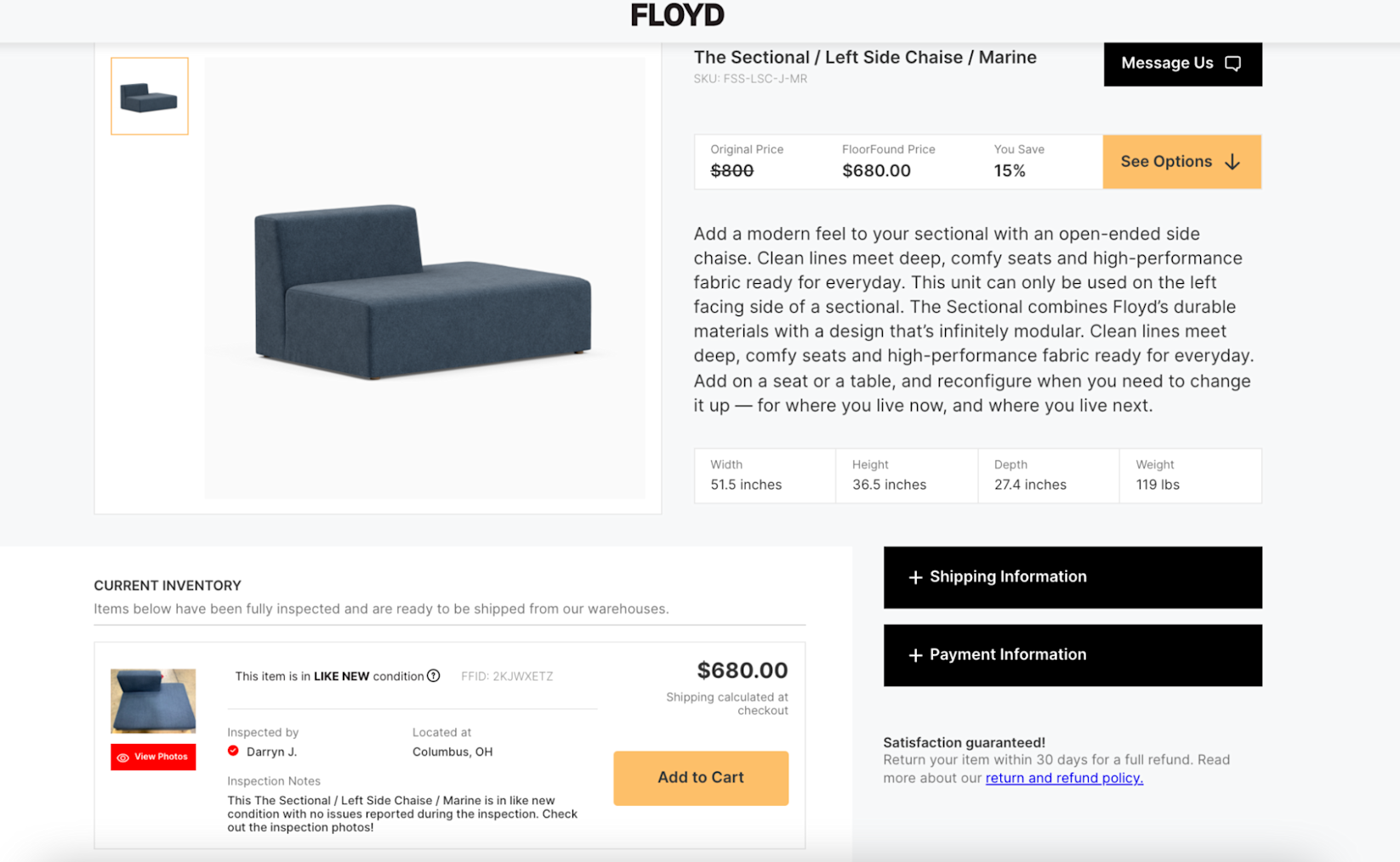
Should I outsource reverse logistics?
Reverse logistics has many moving parts. While it’s possible to handle them internally, it might be time to consider outsourcing reverse logistics once you reach this point:
- You’re receiving too many returns to manage them yourself
- You’re finding it difficult to deal with or dispose of returned inventory
- You don’t have the budget to invest in a reverse logistics team or dedicated technology
Shopify Fulfillment Networkis built for scaling ecommerce businesses. They’ll store your inventory, and pick, pack, and ship orders across most of the United States within two days — freeing up your time so you can spend it on marketing, sales, customer support, and anything else that will help you grow.
The best part? Customers can ship returned products back to a Shopify fulfillment center. Their warehouse team will process the return and inspect the product, returning sellable inventory back to the shelf in preparation for future orders.
Shopify Fulfillment Network is always looking at what our business needs and incorporating those needs into their new services and features. As a business owner, fulfillment is only something you think about when it isn't working well and luckily I never have to think about it."
- Taylor Llewellyn, founderThe Dad Hoodie
Need help with reverse logistics but don’t have the option to outsource it completely? Choose ashipping and return appthat integrates with your Shopify store, such as:
Ecommerce returns are inevitable
While there are steps you can take to prevent returns from overrunning your warehouse, ecommerce returns are an inevitable part of running a business.
Customer retention is at risk if your reverse logistics supply chain doesn’t meet expectations or maintain inventory quality, or if it’s too lengthy. So invest in return processing technology, outline your refund policy, and categorize inventory based on whether it can be resold.
Shopify Fulfillment Networkexists to take those tasks off your plate. Outsource your reverse logistics so you can focus on what you do best.
Reverse Logistics FAQ
What are the 3 activities in reverse logistics?
- Product Returns: Product returns involve physical returns to the original vendor or manufacturer, as well as exchanges, repairs, and warranty services.
- Reverse Logistics Analysis: This step involves analyzing the cost and effectiveness of the process, as well as any potential sources of inefficiency.
- Transportation Planning: The final step in the reverse logistics process is transportation planning. This includes scheduling pickups, arranging transportation, and ensuring that all returned products are delivered to the appropriate destination.
What are the 7 R's of reverse logistics?
- Receive – receipt and inspection of returned goods.
- Review – evaluation of the cause of the return.
- Repair – diagnose and fix defects.
- Refurbish – refurbishment of items for resale.
- Refuse – reject items that are beyond repair.
- Reuse – repurpose the parts or the item.
- Recycle – disassemble and recycle parts or the items
